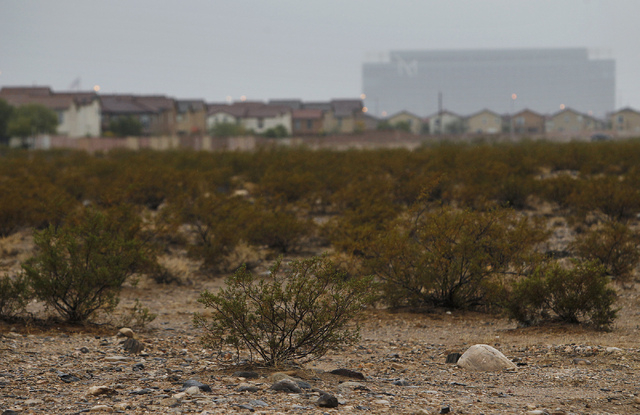Home builder poised to build homes on land once zoned for casinos

It’s a big, square parcel that’s just perfect for a hotel-casino.
In fact, the vacant 38.1 acres on Las Vegas Boulevard South at Starr Avenue were, like almost all of the land around them, long zoned as H-1 — the same land use as South Point, Mandalay Bay and pretty much every other big resort going north on the boulevard.
But something unusual happened in October: A major home builder bought the land and got it rezoned to accommodate hundreds of single-family homes.
Independent observers say they’re not sure it’s necessarily the start of a trend. Other builders might want to see how development goes before they wade in. For now, though, the deal reflects a local market in which new homes are ascendant, while new resorts are looked at as kind of risky gambles. And if other home builders follow suit, and Clark County officials sign off on more rezoning, Las Vegas Boulevard South could hold more than a thousand acres of raw land for housing developers desperate for the stuff, said Rick Hildreth, a senior advisor with real estate firm Land Advisors and a broker involved in the deal.
Texas-based D.R. Horton is the pioneer on this new frontier.
The company closed on the property on Oct. 2, dropping $14.25 million, or $374,000 an acre, to buy it from Las Vegas Blvd & Starr Ave LLC. About two weeks before the deal closed, county officials accepted a requested zoning change to R-2, a residential classification that allows eight to 10 single-family units an acre.
It wouldn’t be the first residential development on Las Vegas Boulevard south of Warm Springs; there are a couple of nearby condo communities, but they were built in the 1960s, before the surrounding land was zoned for resorts.
D.R. Horton officials didn’t return calls seeking comment, but there’s a reason builders in general may be looking for land in unconventional spots, said Nat Hodgson, executive director of the Southern Nevada Home Builders Association.
“We’re landlocked in here pretty good. When you fly out of town, you look down and see all this vacant land, but it’s all hodge-podged up” into five- and 10-acre parcels, Hodgson said. That’s a problem because it can cost hundreds of thousands of dollars to grade lots and bring in streets, sewers and other housing infrastructure. A small parcel means fewer homes to defray those costs, and a less-affordable asking price. So builders prefer 20 acres or more — chunks that are practically impossible to find in the Las Vegas Valley today, Hodgson said.
And builders are definitely looking for new neighborhood prospects. September statistics from local research firm SalesTraq show the median new-home price jumped 34.7 percent year over year, to $267,856, as demand for new homes outstripped supply. Local builders closed on 5,541 units in the first nine months of 2013, up 51.9 percent from closings in the same period of 2012. To replace that sold inventory, they pulled 5,375 building permits from January through September, up 21.4 percent from a year earlier.
Things aren’t quite so hot on the resort-development side. Sure, major operators are adding huge retail complexes in and around existing Strip hotel-casinos. But the market is still trying to absorb the 18,000 rooms it has added since 2007. At 85.4 percent in September, occupancy rates were still below 2007’s 90.4 percent, according to the Las Vegas Convention and Visitors Authority. The average daily room rate was $113.75 in September, down from $132.09 in 2007. With the SLS Las Vegas set to bring 1,720 rooms back online at the former Sahara, and with Genting Group planning to add 3,500 rooms at its Resorts World Las Vegas on the one-time Echelon site, that should be it for a while, analysts said.
“I don’t think, for the foreseeable future, that you’re going to see any type of resort development there because of where the gaming industry is, and where its evolution is,” said John Restrepo, principal of RCG Economics in Las Vegas. “And some of our biggest operators are investing right now in other parts of the world. It’s always a challenge to say what the best use is for a property, because it really is a function of timing. But right now, and for the next few years at least, the best use there is probably a residential use.”
Added Hildreth: “With SLS and Genting, unless tourism goes up drastically a couple of years from now, we could see a trend of occupancy going down.”
Putting homes on the site could also serve a larger purpose, Hildreth said. It will place relatively affordable housing right near the city’s major employment center.
“The city needs to enclose itself, versus spreading out further,” he said. “If we build closer in to the resort corridor, we can consolidate traffic flow coming in and out. The closer locals live to the Strip, the easier it is to get there, whether they’re visiting or working there.”
It’s too soon to tell if D.R. Horton’s buy will kick off a land rush south of the Strip.
“Other builders may watch and see how successful D.R. Horton is,” Restrepo said. “If they do pretty well, other companies will start weighing it against what the market’s like, where interest rates are, and what population growth, job growth and other indicators are doing. If it all looks good, they might start investigating.”
Contact reporter Jennifer Robison at jrobison@reviewjournal.com. Follow @J_Robison1 on Twitter.